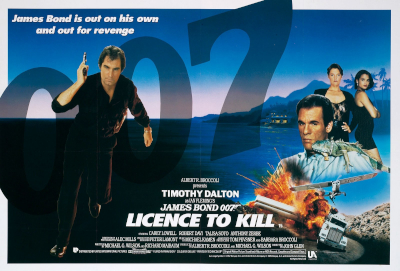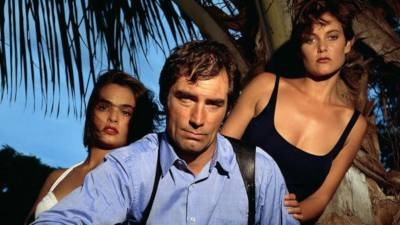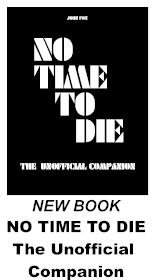|
Licence To Kill - The Reception

John
Glen and EON were greatly dismayed when Licence To Kill received a 15
certificate in Britain. Four different versions of the film were
released with Britain and Europe getting the most watered down version
(in that most cuts were made to violent scenes). The death of Krest in
the decompression chamber (where his head explodes) was one scene that
had to be trimmed. It must have been a slightly new experience for EON
to grapple with censors in this fashion. The 15 certificate in Britain
was a big blow because James Bond films had always traditionally been
enjoyed by children.In a 2012
interview, Barbara Broccoli reflected on realism and violence in Bond
films and seemed to suggest that, in her view, Licence To Kill might
have gone a little too far. "When we did Licence to Kill, that was a
lot more violent," she reflected. "It was the first one that got a
15-rating in the UK, and I think we overstepped the mark there, in
terms of going a bit too far into the realism. So that’s something
we’re always struggling with. When to be realistic, and if so, how
realistic and how much."Studio
cost cutting also (much to the irritation of Cubby Broccoli) threatened
to damage Licence To Kill before it had even been released. Robert Peak
designed stylish teaser illustration and art for Licence To Kill but it
was all dumped for a cheaper and far less effective campaign. MGM also
discarded a campaign created by advertising executive Don Smolen, who
had worked in the publicity campaign for eight previous Bond films.
Certainly, the North American poster for Licence To Kill that did
emerge must rank as one of the worst posters ever produced for Bond and
gives you little clue that it is even promoting a James Bond film. In a
sign of the times, Timothy Dalton was featured in casual clothes in all
the poster art. The lack of the traditional tux did make the art seem
less Bondian and lacking in tradition.Marketing
is definitely something that the modern Bond films are very good at but
Licence To Kill plainly dropped the ball. Licence To Kill was severly
hamstrung by the penny pinching marketing campaign. The marketing on
the Brosnan and Craig films was later excellent. When a Bond film is
released today you would literally have to be living on another planet
not to notice the marketing and promotional campaign. No stone is left
unturned in the quest to inform audiences that Bond is back.One
very shrewd thing the Bond franchise did after Timothy Dalton era was
move the release dates of the films to the winter rather than the
summer. This has generally meant that Bond films will now open at a
time when there is less competition at the box-office. It isn't always
this simple (Tomorrow Never Dies famously found itself up against James
Cameron's Titanic - but then who would have guessed that Titanic would
be so insanely popular and make two billion dollars?) but, for the most
part, opening Bond films around October or November has been a
profitable strategy and new tradition for EON.The
tagline for Licence To Kill was - 'James Bond is out on his own and out
for revenge and out for revenge.' The American trailer for Licence To
Kill was good fun because they got Timothy Dalton in to shoot a few
framing scenes just for the trailer. Dalton frames the trailer by
looking determined and angry in a black outfit and Bond's digital watch
is used as a sort of countdown backdrop to the action. "When you get on
his bad side your number is up!" went the voiceover. One might argue
though that the marketing was overegging the 'oooh, he's really
dangerous in this one' angle and losing some Bondian essence in the
process.John Gardner wrote the
novelisation of Licence To Kill and had a dreadful time trying to tie
the story in with the continuity of the Fleming novels (where Leiter
suffered an identical shark attack in Live and Let Die). In the end
Gardner rather brushed over the return of Milton Krest (from The
Hildebrand Rarity) and had the shark attacking Leiter's false leg from
the previous attack. The Felix Leiter in the Gardner continuity must
rank as one of the unluckiest people in history to experience two
identical shark attacks.A graphic
novel adaptation of Licence To Kill (by Mike Grell, Richard Ashford,
Chuck Austen, Tom Yeates, and Stan Woch) was also released by Eclipse
Books. This adaptation is nothing to write home about and is sometimes
confusing to follow if you aren't very familiar with the film. The main
problem with the graphic novel is that Timothy Dalton refused
permission for his likeness to be used and the illustrations of James
Bond are never consistent in the book. The visual depiction of Bond in
the graphic novel frequently changes to the point you are occasionally
confused as to who he is supposed to be! In one panel he actually looks
like Dalton but in other panels he looks like the Daily Express Bond or
even nothing like Bond at all. The Licence To Kill graphic novel is
most probably one for completist Bond fans only. Timothy
Dalton seemed very happy with Licence To Kill and said in an interview
that it was a 'great leap forward' after Daylights. However, years
later, Dalton would say he liked Daylights better than Licence To Kill.
Dalton did give one slightly gloomy interview when Licence To Kill was
released where he said he feared Licence To Kill might be the last ever
Bond film. He was obviously wrong about this but over the next several
years Bond fans could be forgiven for feeling that his hunch was
depressingly accurate. What might have prompted Dalton's gloomy
prognosis is not known. Maybe he was just tired after a long and
difficult shoot. Licence to Kill
premiered at the Odeon Leicester Square in London on the 13th of June
1989. Bond fans tend to be divided on Licence To Kill to this day and
that was certainly the case with critics in 1989. Time Out praised an
intense Dalton for mitigating a formula that had become 'lacklustre'
while Richard Corliss in Time Magazine thought that Dalton was already
showing signs of being bored by the role! 'The Bond women are pallid
mannequins,' wrote Corlis, 'and so is the misused Dalton – a moving
target in a Savile Row suit. For every plausible reason, he looks as
bored in his second Bond film as Sean Connery did in his sixth.'The
New York Times was more generous and wrote that 'Dalton's glowering
presence adds a darker tone' although they did have some criticisms.
'Dalton is perfectly at home as an angry Bond and as a romantic lead
and as an action hero, but he never seems to blend any two of those
qualities at once. He does not seem at ease with all of Bond's lines
and to the actor's immense credit he seems least comfortable when M
meets him at Hemingway's house, a Key West tourist attraction and tells
him to turn over his gun "I guess it's a farewell to arms" says Mr
Dalton not quite cringing. They have to stop writing lines like that
for the Dalton Bond or he'll really be full of angst.'The
Los Angeles Times was less picky and gave Licence To kill a glowing
review. 'Every once in a while, [the Bond series] pulls in its stomach,
pops the gun from its cummerbund, arches its eyebrow and gets off
another bull's-eye. The newest, Licence to Kill, is probably one of the
five or six best of Bond.' Newsweek called Licence To Kill 'a pure,
rousingly entertaining action movie' but also suggested that Timothy
Dalton was yet to make the part of James Bond his own. Derek Malcom in
The Guardian praised the darker tone of the film but suggested it might
have been a lot better if it had been directed by someone with more
flair than John Glen. Roger
Ebert enjoyed Licence To Kill more than Daylights and wrote - 'On the
basis of this second performance as Bond, Dalton can have the role as
long as he enjoys it. He makes an effective Bond - lacking Sean
Connery's grace and humor, and Roger Moore's suave self-mockery, but
with a lean tension and a toughness that is possibly more contemporary.
The major difference between Dalton and the earlier Bonds is that he
seems to prefer action to sex. But then so do movie audiences, these
days. Licence to Kill is one of the best of the recent Bonds.'The
Globe and Mail was less impressed and wrote - "... they've excised Bond
from the Bond flicks; they've turned James into Jimmy, strong and
silent and (roll over, Britannia) downright American.' Andrew
Pilkington in 007 Magazine was also unimpressed by the film and felt it
was too grim. He said he left the press screening feeling bored and
disappointed. Pilkington felt that Dalton was too 'theatrical' in
Licence To Kill and seemed to have lost the natural quality he
displayed in The Living Daylights. Pilkington noted that there seemed
to be a strange lack of buzz for Licence To Kill and that fans outside
the premiere seemed less numerous than in past years. Sadly,
Licence To Kill floundered in the North American blockbuster box-office
summer of 1989 (Batman, Indiana Jones and the Last Crusade, Lethal
Weapon 2, Ghostbusters 2, Honey I Shrunk the Kids, Star Trek V etc) and
was considered to be a financial disappointment there. It made around
$34 million in the United States - which was plainly disappointing
because Daylights had made over $50 million in America and a number of
films made over $100 million at the North American box-office in the
amazing movie summer of 1989. It is said that MGM basically withdrew
the marketing for Licence To Kill after a week and one can believe that
because the film plainly struggled to hold its position. It
was clearly an unusual sort of year in 1989 because even films that
were not obvious blockbusters like Parenthood and When Harry Met Sally
outgrossed Licence To Kill three or four times over in the United
States that summer. Licence To Kill's tepid performance in North
America was especially galling (and perhaps confusing) for EON because
the tougher tone and increased violence was tailored for the American
market (where action movies seemed to be becoming more violent all the
time). One of the most frustrating things about Licence To Kill's
disappointing box-office haul in North America is that the film scored
high marks with preview audiences in the United States. With a more
committed marketing campaign it could (and probably should) have been a
much bigger hit. Let's remember
though that Licence To kill did good business around the world even if
it didn't completely set the world alight in North America. Licence To
Kill made $156.2 million in total - which was respectable but still $40
million down on The Living Daylights. While John Glen felt that Licence
to Kill was his best Bond film out of the five he had directed, he
later expressed the view that the poor box-office performance of the
film in America was a consequence of studio trouble and a confused
marketing campaign."The thing is
that MGM was going through absolute turmoil at that point," said John
Glen. "We had, I think, three or four different people on publicity
during the course of making it – they were changing every few weeks. So
what happened was that they didn’t seem to put the effort into selling
the picture. If you look at the way they sold Goldeneye, it was a huge
campaign, and they did a great job and spent a lot of money on it. They
spent a lot of money on Licence to Kill, but it didn’t seem to me to be
sold as it should have been. I put that down to the fact that the
studio was upside-down, heads were changing, people were switching
jobs, and new people were coming in all the time. It was a very
difficult period."Amazingly,
speculation about Timothy Dalton's future as James Bond began before
the dust had even settled on Licence To Kill. The British tabloids ran
stories in the summer of 1989 that the studio wanted to replace Dalton
with Pierce Brosnan. The shadow of Brosnan increasingly loomed over
Timothy Dalton's Bond so heavily that in 1990 a number of people noted
that a (soon to be discontinued) cover on John Gardner's latest Bond
novel Brokenclaw seemed to illustrate James Bond to look like Pierce
Brosnan!After Brosnan lost out on
Bond in 1986, Remington Steele (after two comeback movies in which the
lack of enthusiasm by Brosnan was all too apparent) had been swiftly
cancelled again - which made NBC's decision to briefly reactivate the
show feel all the more petty and pointless. It was fairly obvious that
NBC only brought back Remington Steele because of the publicity and
prestige of having the new James Bond actor in one of their shows.
Cubby Broccoli had refused to play this game with NBC though. Brosnan's
career was stuttering circa 1989. The films he had made (Nomads,
Taffin, The Deceivers) received poor reviews and he was still
struggling to escape from the world of TV miniseries. The one bright
spot for Brosnan had been the decent 1987 thriller The Fourth Protocol
- in which he did well as a ruthless Russian agent on a secret mission
to set off a nuclear device in the West. All in all though, Brosnan
would probably have snatched your hand off if you'd offered him James
Bond in 1989.
After
his initial outbursts at NBC, Pierce Brosnan had shown his class by
mostly staying silent about losing out on playing Bond in The Living
Daylights. He did this largely out of respect for Timothy Dalton - who
he personally knew and also liked. Brosnan did though shoot a 007
inspired Diet Coke commercial in 1988 in which he played a James
Bondish Milk Tray Man style character who dodges ninjas and hangs on
the side of the train before settling down in a carriage to enjoy a can
of coke with a beautiful woman.

The
speculation about Dalton's future was obviously a consequence of
Licence To Kill not doing nearly as well in the United States as the
studio and EON might have hoped. While there might conceivably have
been a few MGM executives in 1989 who would have been perfectly happy
to put Dalton in the Aston Martin ejector seat and hire Pierce Brosnan,
there was zero chance of this actually happening. Dalton was under
contract to make a third film and still had the full support of Cubby
Broccoli and EON.Besides, there
was no reason to believe that with a better marketing campaign (and a
bit more luck with the box-office competition next time around) a third
Dalton film couldn't be a success. It's not as if Timothy Dalton's two
Bond films had completely bombed. Both got plenty of positive reviews
and turned in a profit. If anything, the prospect of a third Dalton
film was rather intriguing now because it would fascinating to see what
direction it took. Cubby
Broccoli made some public comments after the dust settled on Licence To
Kill where he suggested that Licence was lacking some of the wry humour
and fun which audiences had come to expect from James Bond. Dalton's
third Bond film then was expected to undergo a slight course correction
and be a slightly lighter and more outlandish affair than Licence To
Kill. There's no reason why Dalton couldn't have worked in a film that
was less 'angry' than Licence To Kill. Dalton had already displayed
some charm in the generally lighter Living Daylights. It wasn't as if
he was only capable of playing a grumpy James Bond intent on killing
everyone. Despite the occasional
overblown claim by the producers that Bond must reflect the real world
this has never really been the case. We never saw Bond fighting ISIS or
battling child traffickers or people smugglers. We never saw Bond
fighting in the Falklands War. We never saw him fighting in the Gulf
Wars. The topicality of Bond is a superficial sort of gloss that
amounts to one of the writers calling Donald Trump a real life Bond
villain or Barbara Broccoli saying that in today's climate Bond women
can no longer wander around in bikinis with a secret microtape stuffed
down their underwear. The Dalton films were grounded by the standards
of Bond but they were not radically realistic. Another
criticism of Dalton's Bond that surfaced after Licence To Kill was lack
of humour. Humour was the biggest difference between the James Bond
books written by Ian Fleming and the James Bond film franchise created
by Cubby Broccoli and Harry Saltzman. The films gave Bond (played by
the peerless Sean Connery) deadpan quips and witty lines. Humour became
an essential part of the franchise. Sean Connery and Roger Moore had
impeccable timing when it came to dispensing the trademark Bond quips.
These quips sounded less natural though coming from the mouth of
Timothy Dalton. Timothy Dalton always seemed to be searching for a
subtext in his lines but sometimes a quip is just a quip and didn't
have to have any great significance beyond that.It's
not really as if the Dalton era required much of a course correction.
Both of his films had a respectable critical reception. Years later, no
one suggested Daniel Craig should leave the role after his second film
Quantum of Solace proved to be a critical misfire so why should Dalton
have had to leave after Licence To Kill? All it probably required was
for a third Dalton film to be more like Daylights than Licence To Kill
and freshen things up with a new director. A new director was clearly
on the cards anyway as Dalton seemed less than enthusiastic at the
prospect of working with John Glen again. Timothy Dalton is alleged to
have requested at the time that his third Bond film should have a new
director. A few years later
Dalton left the production of Christopher Columbus: The Discovery after
John Glen came onboard as director in place of George Pan Cosmatos. In
his memoir, John Glen said - "While waiting for his third Bond
assignment, Tim had agreed to play Columbus. My arrival, however,
seemed to initiate a change of heart and Tim soon decided he didn't
want to appear in the film after all. I don't know whether Tim thought
that appearing in another John Glen film would typecast him, but I hope
that his departure wasn't entirely due to me. Whatever his reasons, the
official story was that Tim had decided not to play Christopher
Columbus because of 'creative differences' - whatever that means." It
was a lucky escape for Dalton in the end because Christopher Columbus:
The Discovery bombed and swept the board at the Golden Raspberries. The
failure of the film pretty much ended Glen's career as a movie director
and he was reduced to directing episodes of Gerry Anderson's Space
Precinct for television.In their
overview of Licence To Kill, 007 Magazine suggested that the third
Dalton film should be directed by John McTiernan, Richard Donner, or
Lewis Gilbert. Although these would clearly have been interesting and
talented choices it is probably doubtful that two Hollywood directors
as high profile (not to mention expensive) as McTiernan and Donner
would have been realistic possibilities at the time. John McTiernan was
red hot after Predator and Die Hard and would probably have been too
busy anyway. Lewis Gilbert had of course directed You Only Live Twice,
The Spy Who Loved Me, and Moonraker for EON. It's highly doubtful EON
would have gone back to Gilbert (who was knocking on a bit by now) but
it's a rather enticing thought to think of the director of The Spy Who
Loved Me having a stab at a Tim Dalton film! I'd have paid money to
watch that.Nothing too radical
was really required for a third Dalton film. If anything it just needed
to be a little more conventional. The Bond franchise had faced far
bigger headaches in its past and would again in the future. There was
the headache of replacing Connery for OHMSS and then the headache of
replacing Connery AGAIN after Diamonds Are Forever. The mediocre
reception to The Man with the Golden Gun required something of a course
correction back to the extravaganza Bonds of the sixties. The excesses
of Moon raker then required a course correction to the more grounded
(for Roger Moore at least) For Your Eyes Only. Years later, the
creative dead end experienced by Barbara Broccoli and Michael G. Wilson
with Die Another Day led to a four year hiatus and a complete reboot of
the franchise. Making a third Timothy Dalton film was child's play
compared to some of these past and future headaches.* The above article is an excerpt from the book Timothy Dalton's James Bond - The Retrospective.
BUY THE BOOK HERE
© 2021
Alternative 007
|



|






